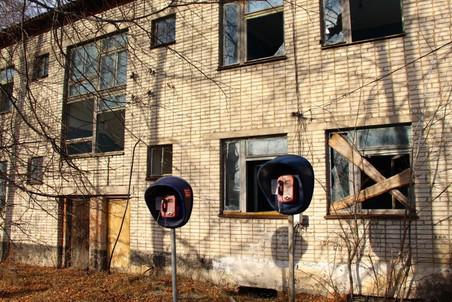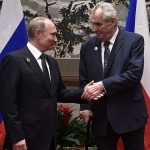Ideology schemes are essential to modern Russia. They are a key pillar for the Kremlin elites to address challenges. Lots of them have notably changed their traditional meaning in the last decades. Economic decline, challenge to the elites to fall from power and their constant uncontrolled wealth accumulation are the key reasons.
The narratives based on ideology schemes are sparkly introduced amid welfare loss by the people, inevitably triggering decline of trust in the elites. The Kremlin therefore needs both to divert the people from pressing issues and to urge them to unite behind common ideas. The first one scales back the protests, the second – “sews the country together” for the good of elites and sets up a unified value system that enables to hold power and keep on accumulating wealth. Ideology schemes, moreover, allow for aggressive foreign policy without fundamental social shakeups within the country.
The basic techniques are to shape phantom threats, to approve the “messianism” concept and to set up a unique value system unaffected by material wealth. All these techniques, as well as the ideology schemes themselves, are of clearly pronounced totalitarian nature and might be compared to the practices used by the Soviet Union, Nazi Germany and North Korea. The elites are concurrently seeking to consolidate control over the information delivery channels, thus monopolizing the process of implanting notions and values and allowing for effective dissent head-off.
Such techniques cannot exist in a democracy, even a transit one. But Russia, de facto, has long abandoned building a democratic society and retains the remnants of institutional front face just for its world brand.
Let us consider the main ideology schemes lying at the core of the value system today, stepped up by the Kremlin and espoused by most of the people living in Russia. It is interesting that not just the Putin regime’s sympathizers, but also those who oppose it are in sync about most of these notions. A stable system is set up, therefore, difficult to impossible to be wiped out quickly by altering the elites.
Soviet Union = Russia.
These notions were not identical for the public mind in the 90s and 00s, and the national narrative scheme looked somewhat different. The ex-Soviet republics acted as sub-states with corresponding challenges that only Russia could address. Russia acted as the “elder brother” who treated the independent states that received sovereignty with indulgence and freeze. But no one disputed the very principle of sovereignty. Tables were turned in the 10s. The Soviet Union started to be viewed just as a form of organization for Great Russia. This, in turn, primarily hauls the perception of space and external borders of the Russian Federation. Today the Kremlin is giving rise to the narratives facilitating warfare and influence ops in all ex-Soviet republics, and then in ex-Warsaw Pact countries.
Powerful Russia scares the world.
Dominating power cult is peculiar to any and all totalitarian rule. In the current scenario, it also makes Russian people shift the emphasis in perceiving the reality amid tough crisis in economy and infrastructure. Most of the Russians are proud of themselves and, at the same time, of their country (the “we” category is a key one in totalitarian societies) not because they or their society have achieved gains, but because they are sure the rest of the world is afraid of Russia’s weapons and sophisticated military technologies. It does not matter this power is vastly exaggerated. Russia also puts the wind up and spreads fakes about its power to maintain special psyops abroad. This ideology scheme is not new. It has been exploited since at least the 19th century. For example, the famous lines from “The Bronze Horseman” by the cult Russian poet Alexander Pushkin known by just every educated Russian are: “Here’s where we’ll threaten the Swedes from, where we’ll set a city’s first stones, to spite our power-drunk neighbors.” Similar techniques were used by the Soviet Union before the Second World War and during the “arms race”. This ideology scheme is doubled down today. Besides positive internal political effect for the Kremlin elites, it has foreign policy ramifications as well: Russia is not going to work with the West in the format of peaceful mutually beneficial cooperation.
Invincible people.
“Russia incites fear” ideology scheme would not work so well not having been based on the feeling that every Russian belongs to it. This is achieved by implanting the notion that not just defense industry progress incites fear, but also the Russians’ nature that differs from others. Russia doubles down on “rewriting history” technique, shifting emotional shades and, therefore, building the “heroic ancestors” cult, who saved the world civilization. The celebration of victory in WW II has nearly reached the dimension of totalitarian cult. Reconstruction is popularly widespread, with constant emphasis on historical interrelation by generations and the immortal heroes. It should be noted that Russia’s leaders exploited this ideology scheme in propaganda of the 19th-20th centuries as well. “Patriotic” and “people’s” war terms are peculiar to the Russian semantic field for Russia’s campaign of 1812 and for the WW II. The “invincible people” ideology scheme wakes up a feeling that every Russian is involved in the governmental activity and is concurrently more ascetic on daily challenges that never end in Russia.
Russia advocates traditional virtues.
Protecting rights of women, LGBT, dissidents, subcultures, including religious ones, juvenile justice – these and many other fundamental principles of modern West are considered as alien, Western, harmful by Russia, as a subject to condemn and prohibit. Those who hold different views are subject to persecution, segregation, violence and public censure. The ideology scheme therefore shapes an internal opinion that Russia is the only “island” of traditional virtues that will “save” the country in future. Russia is massively broadcasting this ideology abroad as well, thus increasing the number of its followers in the countries with social groups of similar views. This is primarily subject to a part of radical Muslim world and southern Catholic Europe.
Putin secures Russia’s future.
Vladimir Putin has been heading Russia for 20 years. The 2008-2012 castling move, when he was the head of government, did not affect the core of the matters. Such a long tenure by Vladimir Putin cannot but affect the emerged request to alter the elite, even in such undemocratic society Russia makes for today. So, the Kremlin is implanting two ideology schemes into the heads of Russians. First: Putin has turned Russia around and it would have been much worse without him. The second – stemming from the first – Putin secures future for Russia. The image of “eternal” Putin therefore meets the paternalistic demand by a part of Russian society as well. Paternalism and personality cult are generally typical for Russia, never having lived, in fact, without a single leader for a long period, as real representative democracy.
The Stalin cult revival.
Several generations have succeeded as Vladimir Putin is at the helm, with middle-aged and young people gaining importance in social strata. They differ psychologically from the generation that got used to living in Soviet totalitarianism. To get in their good graces, historic evidence is deliberately replaced and positive emotional assessment for the totalitarian past is implanted. Gradual revival by the cult of Stalin is one of the key narratives implanted here. Following his death, his policy line was criticized even during the Soviet era, and the main blow to the image was in the 80s-90s of the twentieth century. The things go vice versa today. The positive image by Stalin as a nationwide strong leader who managed to make Russia “great” at difficult times is part of the all-Russian narrative. Credibility for Stalin went up by 12 percentage points from 2018 to 2019, and from 29% in 2018 to 41% in 2019, the Levada Center claims. The indicators of a positive assessment for Stalin’s role in country’s life keep on going up as well: they reached 70% in 2019.
Stalin’s image is clearly messianic by nature, though. The Kremlin is tackling several issues in this way. First, it finds historical excuses for the current drive by Russia towards a tough totalitarian rule and legalizes the idea of dictatorship for the people. Second, we believe the Kremlin elite is gearing up for a new leader of pronounced dictatorial nature to emerge, who will come to replace Vladimir Putin.
Aggression by the West.
A totalitarian rule cannot exist without internal or external enemies. And these enemies should be linked. All social groups standing out of state clichés are labeled as foreign enemy allies. Modern Russia has been long persecuting dissidents. These are people who uphold the “Western” values, as a rule, while the West itself has turned into a single external enemy today, hawkish towards Russia and its people, eager to seize / dismember / weaken this country both from inside and outside. And specific narratives by this ideology scheme alter depending on the geopolitical landscape – the Kremlin informationally boosts the aggression by specific countries. It might be Georgia, Ukraine, US, Poland or UK – it all depends on the situation on the ground. But one thing remains unchanged – the West is hawkish. It also speaks for the fact the Kremlin is not going to change the geopolitical vector of development in the years to come.
A special path for the Russian world.
Many regimes in Russia have emphasized its own development path for centuries. Anyone in Russia can hardly challenge indeed this ideology today. Even those who follow the European development path always note that Russia is nevertheless going its own way and the Western democracy principles do not suit it one hundred percent.
This stance is very convenient for the Kremlin, as it allows not to use the criteria to assess progress used by the West. This, in turn, facilitates any social and political experiments, claiming they are effective, even if the case study suggests the opposite.
The special path for the Russian world is a convenient ideology scheme enabling to succeed in developing a shut-in totalitarian society for the benefit of corrupt elites. And the more social and political schemes are designed to this end, the more the path by the Russian world will contrast with democracy principles.




